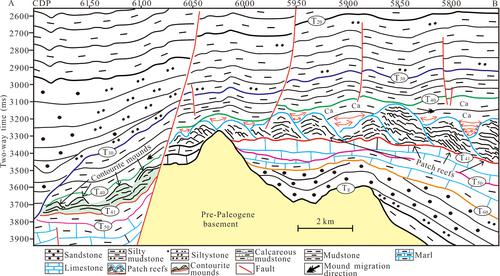当前位置:
X-MOL 学术
›
Acta Geol. Sinica Engl. Ed.
›
论文详情
Our official English website, www.x-mol.net, welcomes your feedback! (Note: you will need to create a separate account there.)
Seismic Recognition and Origin of Miocene Meishan Formation Contourite Deposits in the Southern Qiongdongnan Basin, Northern South China Sea
Acta Geologica Sinica-English Edition ( IF 3.3 ) Pub Date : 2021-01-08 , DOI: 10.1111/1755-6724.14626 Yangwei FENG 1, 2, 3, 4 , Yan REN 1 , Chengfu LYU 5 , Peng ZHANG 1 , Ying CHEN 6 , Li JIN 4
Acta Geologica Sinica-English Edition ( IF 3.3 ) Pub Date : 2021-01-08 , DOI: 10.1111/1755-6724.14626 Yangwei FENG 1, 2, 3, 4 , Yan REN 1 , Chengfu LYU 5 , Peng ZHANG 1 , Ying CHEN 6 , Li JIN 4
Affiliation

|
Research into the contourite deposits in the Upper Meishan Formation of the southern Qiongdongnan Basin in South China Sea is weak; their characteristics, distribution and original geological conditions are not clear. Using geological and geophysical methods including seismic and drilling data, based on seismic reflection characteristics, geometrical configuration description, and wave impedance inversion, two types of contourite deposits are recognized. Contourite deposits have blurred boundaries between each deposit and disordered internal seismic reflections; They are mound‐shaped only in transverse section, and banded in the longitudinal direction. Type I contourite deposits are conical, with medium‐high amplitude, low‐continuity, low‐frequency mound‐shaped seismic facies, and subparallel‐chaotic reflections internally. These deposits are conical with sharp tops, the canal between mounds is V‐shaped and deep. The western wing is gentle and the eastern wing is steep, with the slope toe mostly between 10° and 20°, and width height ratio about 1–2. Type II contourite deposits are flat, exhibiting medium‐amplitude, medium‐continuity, low‐frequency mound‐shaped seismic facies, with subparallel weak reflections internally. Their mounds are flat with gently arced tops, with shallow canals between. The slope toe is between 5° and 10°, with a width height ratio of about 2–5. The wave impedance value of these contourite deposits is 4.6 kg/m3×m/s to 6.8 kg/m3×m/s, about 5.8 kg/m3×m/s on average, which is presumed to represent marly‐calcareous clastic sediments. The contourite deposits mainly develop beneath the slope break at the margin of the fault‐controlled platform in the Southern Uplift zone of the basin. In plane view, they are distributed approaching a west‐to‐east direction, and in section, lie in low‐lying areas near the faults at fault‐controlled terraces of the Southern Uplift zone, with a paleo‐current direction nearly west‐to‐east. The paleotectonic setting of the gentle monoclinic platform was favorable for the development of such contourite deposits. The intensification of the Mid‐Miocene deepest bottom current gave rise to the contourite‐forming currents around the Southern Uplift zone in the northern South China Sea, which flow from Hainan Island to the Xisha Trough in a nearly west‐to‐east direction leading to the contourite deposits developing in the late Mid‐Miocene transgressive environment, with multiple slow sea‐level fall cycles.
中文翻译:

南海北部琼东南南盆地中新世梅山组共形沉积物的地震识别与成因
南海南部琼东南盆地南部梅山组上等长线矿床的研究薄弱。其特征,分布和原始地质条件尚不清楚。使用包括地震和钻探数据在内的地质和地球物理方法,基于地震反射特征,几何构造描述和波阻抗反演,可以识别出两种类型的轮廓岩矿床。轮廓岩沉积物之间的边界模糊,内部地震反射无序。它们仅在横截面上呈丘状,并在纵向上束紧。I型等速线矿床呈圆锥形,内部具有中高振幅,低连续性,低频丘状地震相和次平行混沌反射。这些沉积物呈圆锥形,顶部尖锐,丘间的运河呈V形且深。西翼平缓,东翼陡峭,坡脚趾大多在10°至20°之间,宽高比约为1-2。II型轮廓岩沉积物是平坦的,表现出中等振幅,中等连续性,低频丘状地震相,内部具有次平行的弱反射。他们的土墩平坦,顶部呈弧形,中间有浅渠。坡脚趾在5°到10°之间,宽高比约为2–5。这些轮廓石沉积物的波阻抗值为4.6 kg / m II型轮廓岩沉积物是平坦的,表现出中等振幅,中等连续性,低频丘状地震相,内部具有次平行的弱反射。他们的土墩平坦,顶部呈弧形,中间有浅渠。坡脚趾在5°到10°之间,宽高比约为2–5。这些轮廓石沉积物的波阻抗值为4.6 kg / m II型轮廓岩沉积物是平坦的,表现出中等振幅,中等连续性,低频丘状地震相,内部具有次平行的弱反射。他们的土墩平坦,顶部呈弧形,中间有浅渠。坡脚趾在5°至10°之间,宽度与高度之比约为2-5。这些轮廓岩沉积物的波阻抗值为4.6 kg / m3 ×m / s至6.8 kg / m 3 ×m / s,约5.8 kg / m 3平均×m / s,被认为代表了马里钙质碎屑沉积物。在盆地南部隆升带断层控制平台的边缘,边坡沉积物主要生长在斜坡断裂的下方。从平面上看,它们分布的方向是从西向东的,而在剖面上,它们位于南部隆起带断层控制阶地断层附近的低洼地区,古流向接近西至-东。温和的单斜平台的古构造环境有利于此类轮廓岩沉积的发展。中新世中最深海流的激化引起了南海北部南部隆起带周围的轮廓岩形成流,
更新日期:2021-02-22
中文翻译:

南海北部琼东南南盆地中新世梅山组共形沉积物的地震识别与成因
南海南部琼东南盆地南部梅山组上等长线矿床的研究薄弱。其特征,分布和原始地质条件尚不清楚。使用包括地震和钻探数据在内的地质和地球物理方法,基于地震反射特征,几何构造描述和波阻抗反演,可以识别出两种类型的轮廓岩矿床。轮廓岩沉积物之间的边界模糊,内部地震反射无序。它们仅在横截面上呈丘状,并在纵向上束紧。I型等速线矿床呈圆锥形,内部具有中高振幅,低连续性,低频丘状地震相和次平行混沌反射。这些沉积物呈圆锥形,顶部尖锐,丘间的运河呈V形且深。西翼平缓,东翼陡峭,坡脚趾大多在10°至20°之间,宽高比约为1-2。II型轮廓岩沉积物是平坦的,表现出中等振幅,中等连续性,低频丘状地震相,内部具有次平行的弱反射。他们的土墩平坦,顶部呈弧形,中间有浅渠。坡脚趾在5°到10°之间,宽高比约为2–5。这些轮廓石沉积物的波阻抗值为4.6 kg / m II型轮廓岩沉积物是平坦的,表现出中等振幅,中等连续性,低频丘状地震相,内部具有次平行的弱反射。他们的土墩平坦,顶部呈弧形,中间有浅渠。坡脚趾在5°到10°之间,宽高比约为2–5。这些轮廓石沉积物的波阻抗值为4.6 kg / m II型轮廓岩沉积物是平坦的,表现出中等振幅,中等连续性,低频丘状地震相,内部具有次平行的弱反射。他们的土墩平坦,顶部呈弧形,中间有浅渠。坡脚趾在5°至10°之间,宽度与高度之比约为2-5。这些轮廓岩沉积物的波阻抗值为4.6 kg / m3 ×m / s至6.8 kg / m 3 ×m / s,约5.8 kg / m 3平均×m / s,被认为代表了马里钙质碎屑沉积物。在盆地南部隆升带断层控制平台的边缘,边坡沉积物主要生长在斜坡断裂的下方。从平面上看,它们分布的方向是从西向东的,而在剖面上,它们位于南部隆起带断层控制阶地断层附近的低洼地区,古流向接近西至-东。温和的单斜平台的古构造环境有利于此类轮廓岩沉积的发展。中新世中最深海流的激化引起了南海北部南部隆起带周围的轮廓岩形成流,


























 京公网安备 11010802027423号
京公网安备 11010802027423号